Abstract
Glucose-negative mutants of Mycoplasma capricolum were selected for growth on fructose in the presence of the toxic glucose analog alpha-methyl-D-glucopyranoside. The mutants are defective in the phosphoenolpyruvate:sugar phosphotransferase system for glucose. One mutant, pts-4, was studied in detail. It lacks the glucose-specific, membrane-bound enzyme II, IIGlc, as well as the general, low-molecular-weight, phosphocarrier protein, HPr. In place of the latter, however, it has a fructose-specific protein, HPrFru. Consistent with these changes, the mutant lost the ability to grow on glucosamine and maltose but retained its ability to grow on sucrose. In the glucose-negative mutant, glucose did not regulate the intracellular concentration of cyclic AMP. The intracellular concentration of cyclic AMP in M. capricolum is regulated by the presence of metabolizable sugars. In the wild-type, both glucose and fructose reduced the intracellular concentration of cyclic AMP; however, in the glucose-negative mutant, glucose no longer regulated the intracellular level of cyclic AMP.
Full text
PDF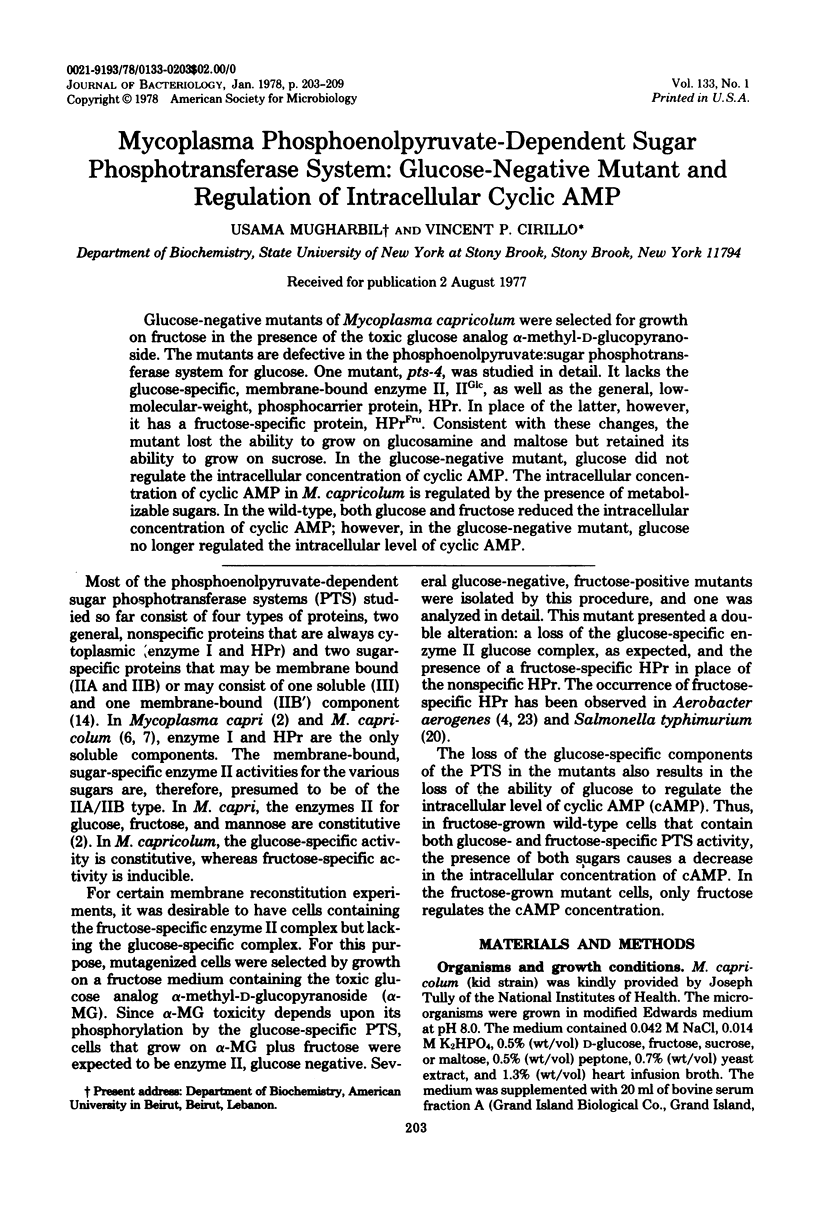
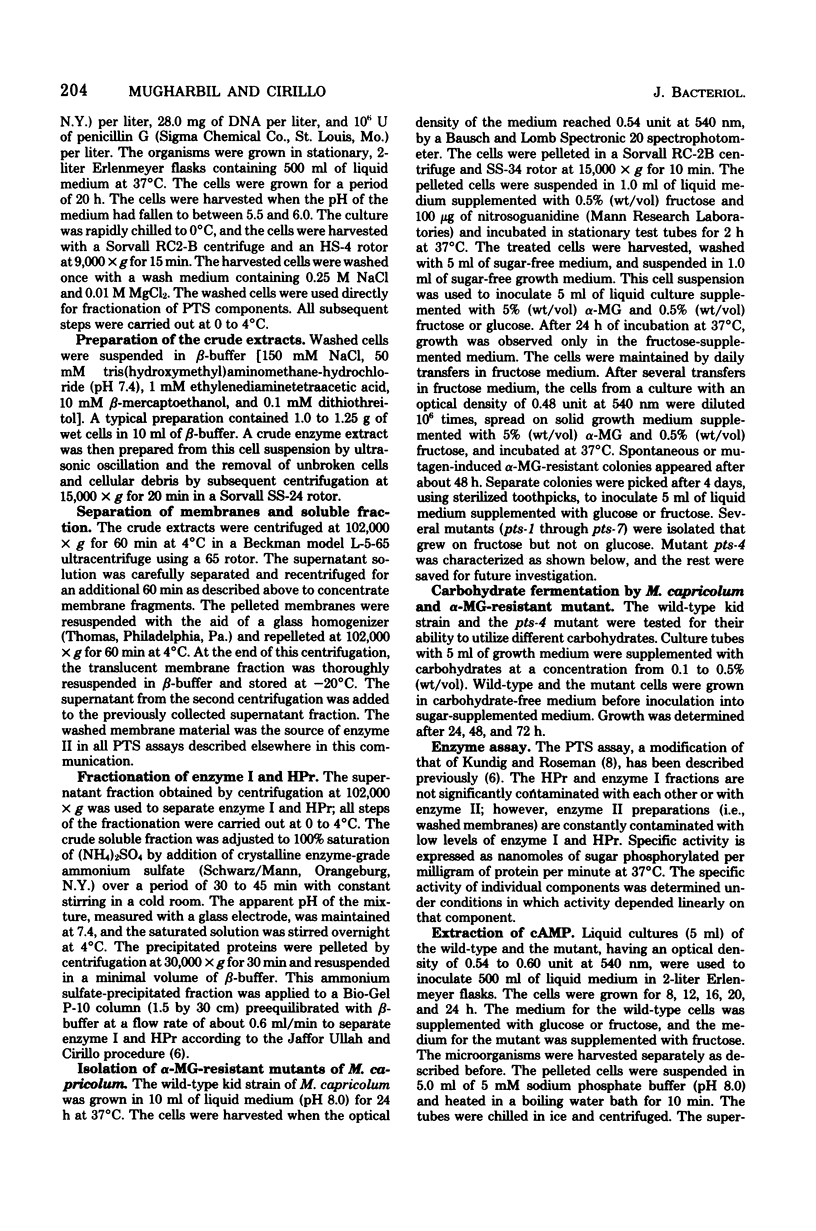
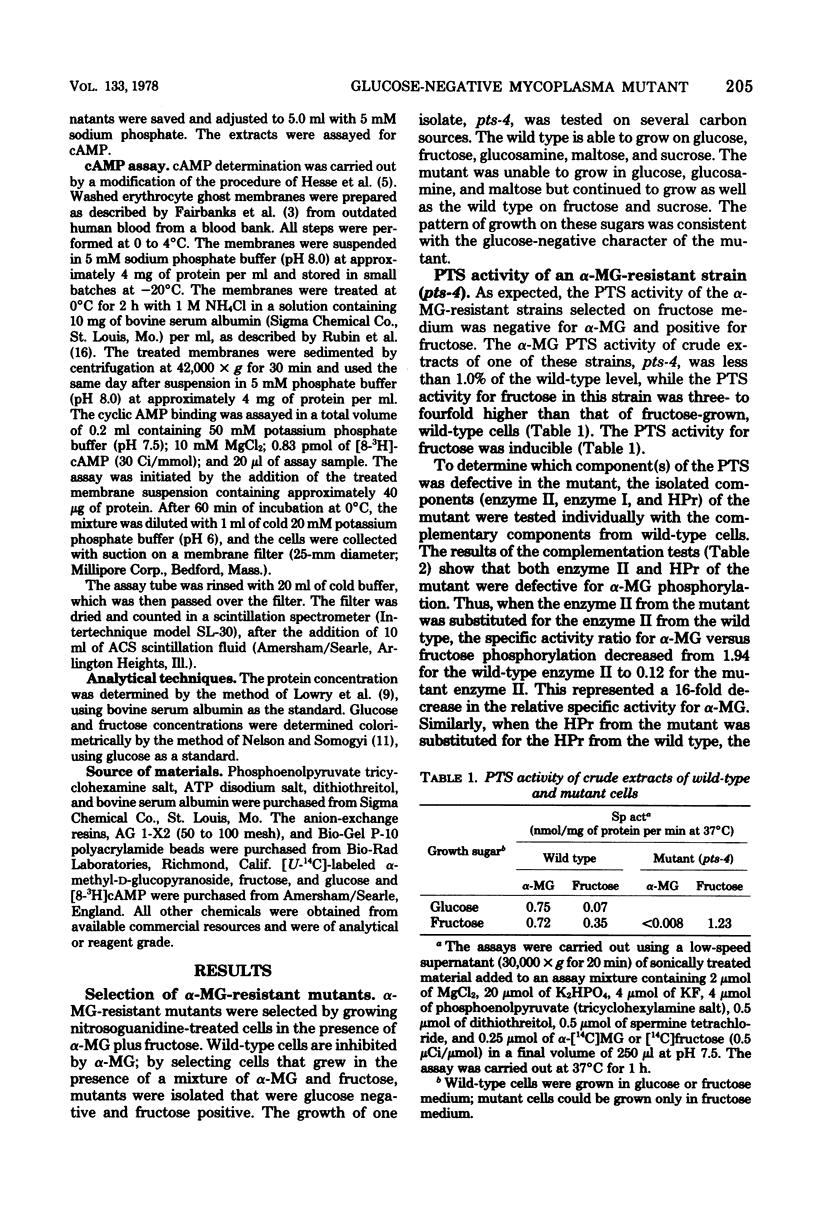
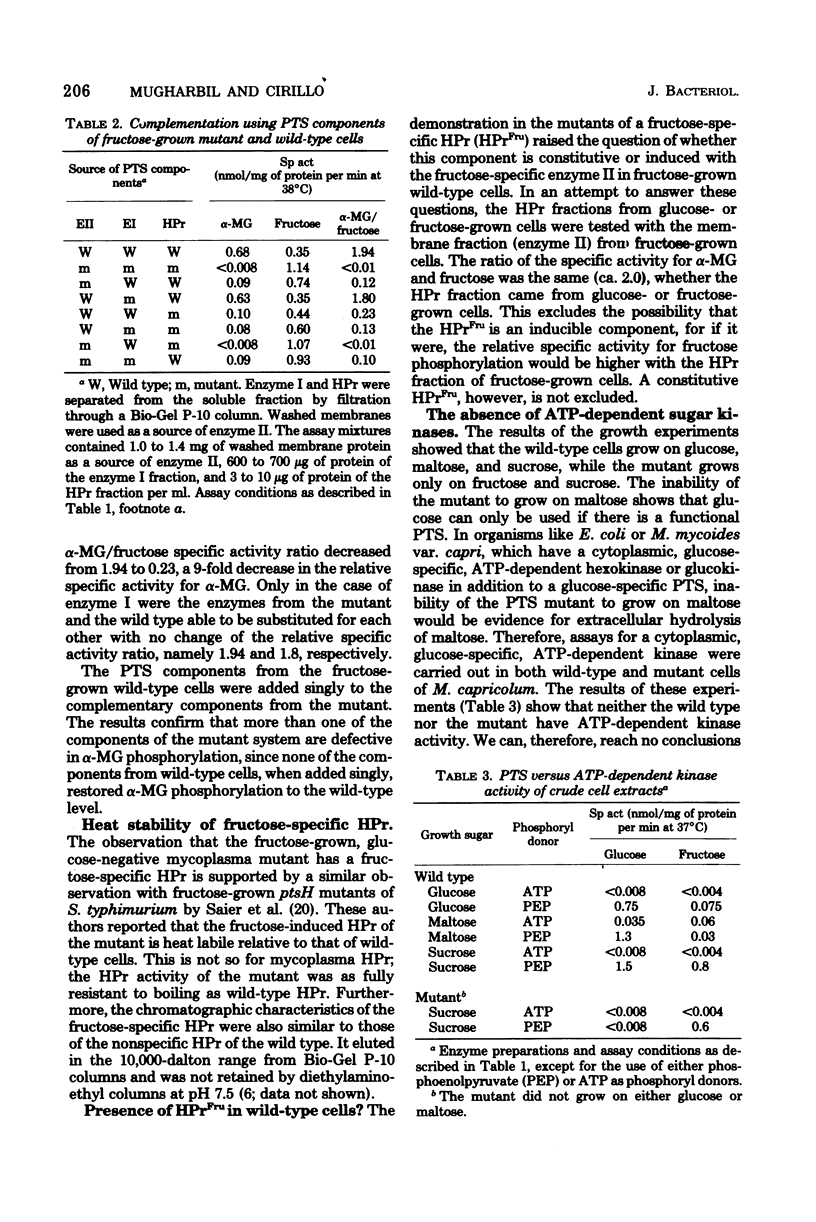
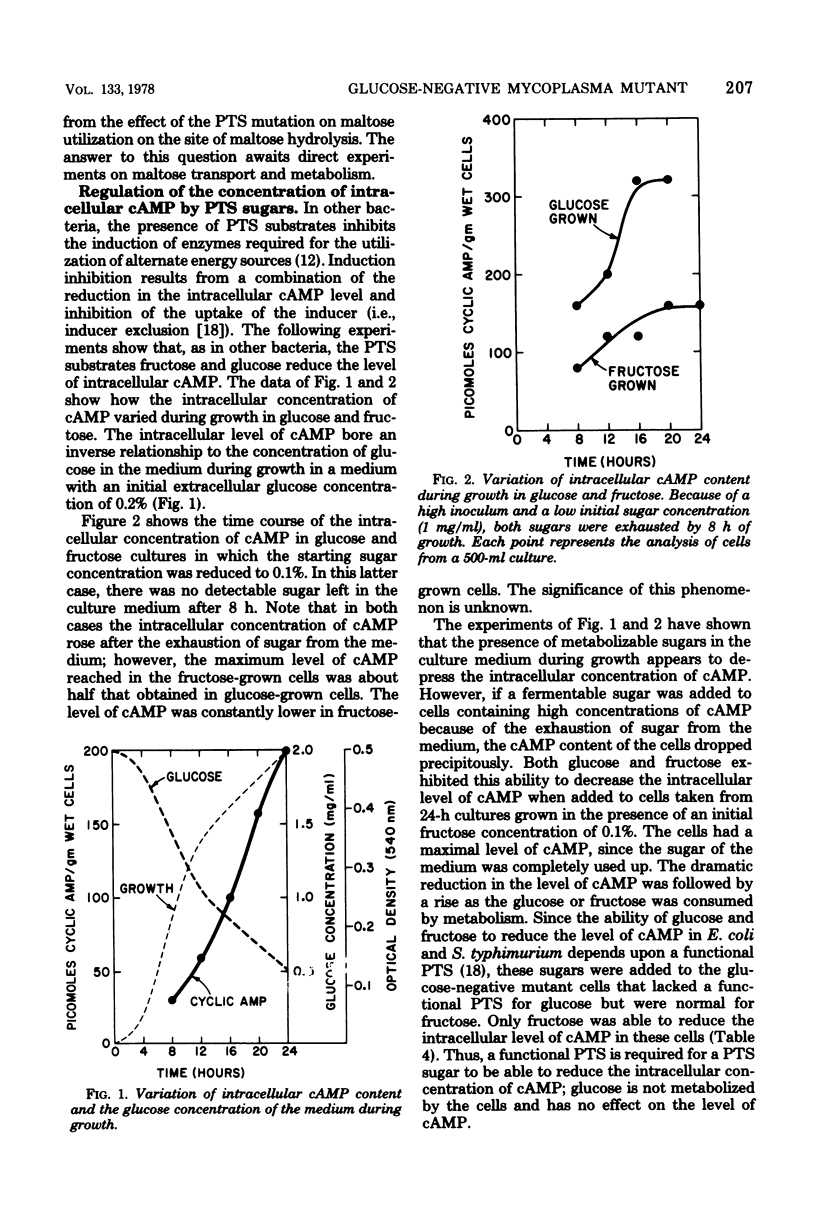
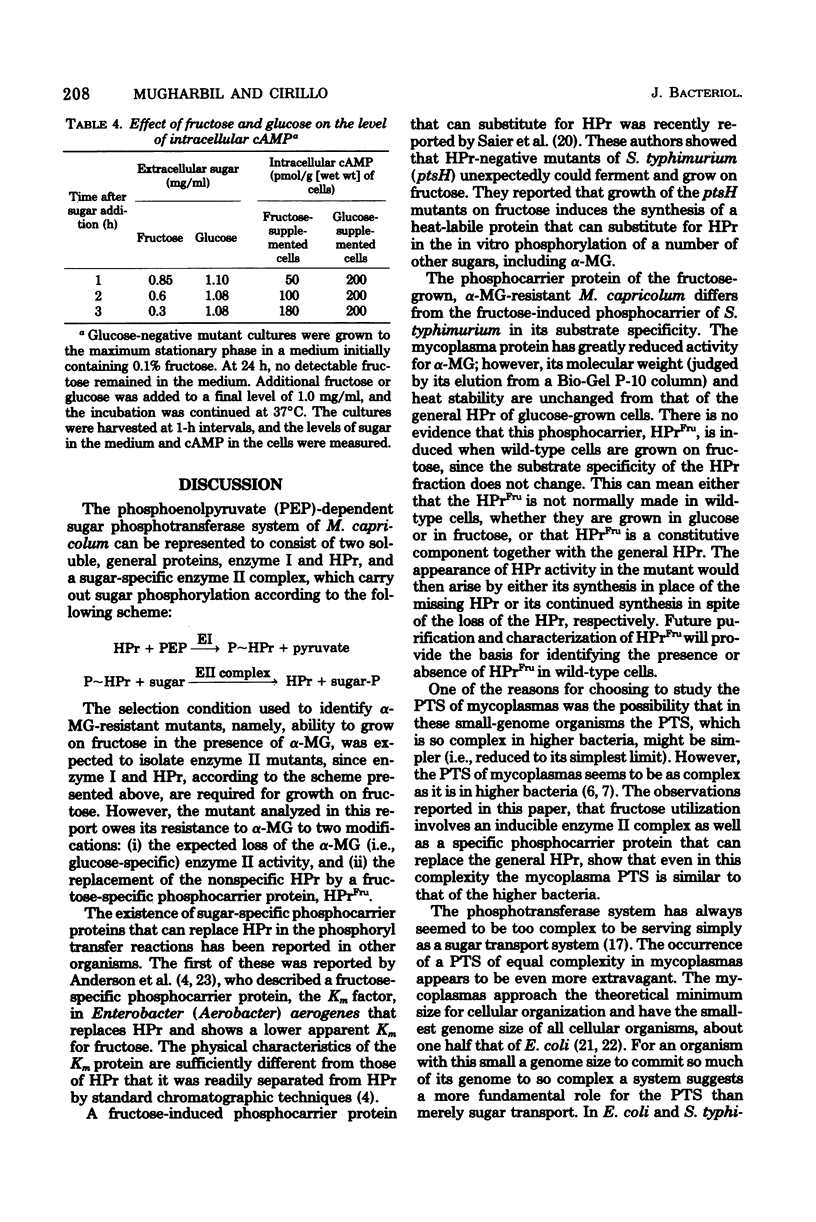
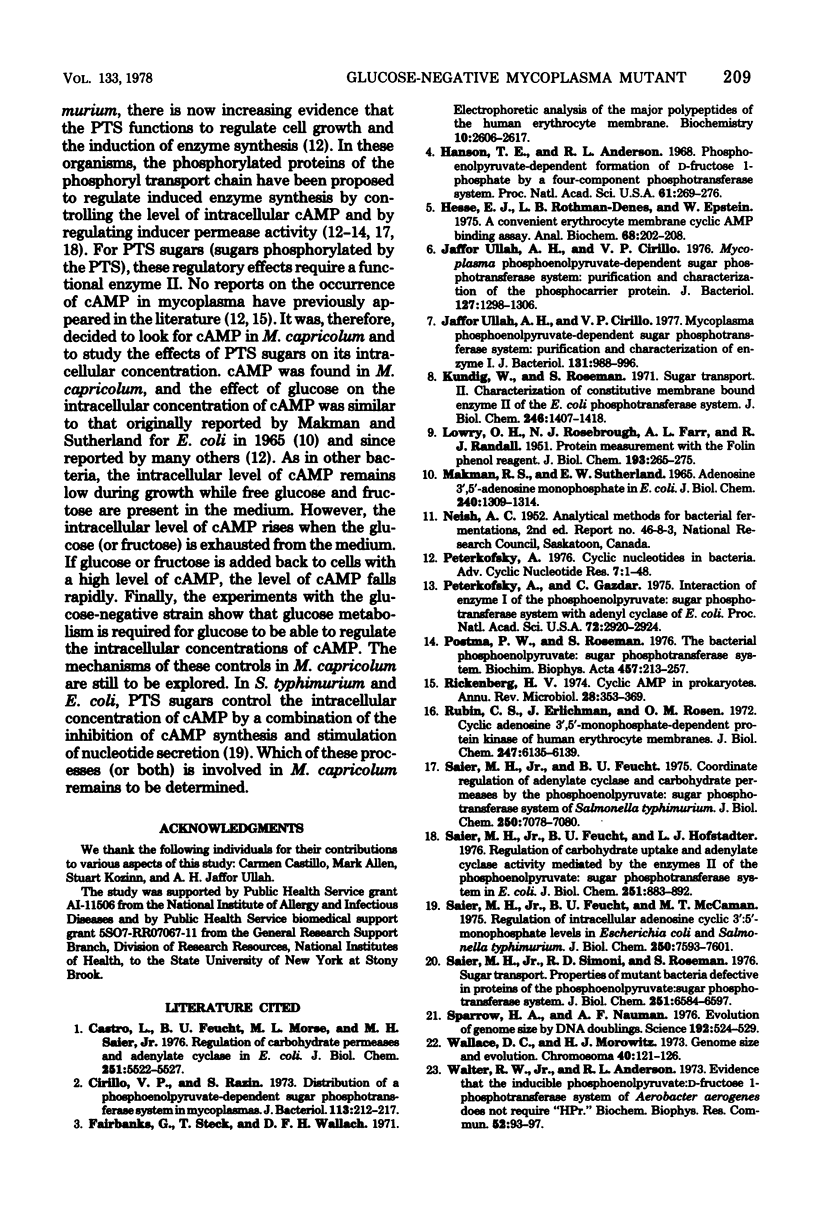
Selected References
These references are in PubMed. This may not be the complete list of references from this article.
- Cirillo V. P., Razin S. Distribution of a phosphoenolypyruvate-dependent sugar phosphotransferase system in mycoplasms. J Bacteriol. 1973 Jan;113(1):212–217. doi: 10.1128/jb.113.1.212-217.1973. [DOI] [PMC free article] [PubMed] [Google Scholar]
- Fairbanks G., Steck T. L., Wallach D. F. Electrophoretic analysis of the major polypeptides of the human erythrocyte membrane. Biochemistry. 1971 Jun 22;10(13):2606–2617. doi: 10.1021/bi00789a030. [DOI] [PubMed] [Google Scholar]
- Hanson T. E., Anderson R. L. Phosphoenolpyruvate-dependent formation of D-fructose 1-phosphate by a four-component phosphotransferase system. Proc Natl Acad Sci U S A. 1968 Sep;61(1):269–276. doi: 10.1073/pnas.61.1.269. [DOI] [PMC free article] [PubMed] [Google Scholar]
- Hesse J. E., Rothman-Denes L. B., Epstein W. A convenient erythrocyte membrane cyclic AMP binding assay. Anal Biochem. 1975 Sep;68(1):202–208. doi: 10.1016/0003-2697(75)90695-8. [DOI] [PubMed] [Google Scholar]
- Jaffor Ullah A. H., Cirillo V. P. Mycoplasma phosphoenolpyruvate-dependent sugar phosphotransferase system: purification and characterization of enzyme I. J Bacteriol. 1977 Sep;131(3):988–996. doi: 10.1128/jb.131.3.988-996.1977. [DOI] [PMC free article] [PubMed] [Google Scholar]
- Kundig W., Roseman S. Sugar transport. II. Characterization of constitutive membrane-bound enzymes II of the Escherichia coli phosphotransferase system. J Biol Chem. 1971 Mar 10;246(5):1407–1418. [PubMed] [Google Scholar]
- LOWRY O. H., ROSEBROUGH N. J., FARR A. L., RANDALL R. J. Protein measurement with the Folin phenol reagent. J Biol Chem. 1951 Nov;193(1):265–275. [PubMed] [Google Scholar]
- MAKMAN R. S., SUTHERLAND E. W. ADENOSINE 3',5'-PHOSPHATE IN ESCHERICHIA COLI. J Biol Chem. 1965 Mar;240:1309–1314. [PubMed] [Google Scholar]
- Peterkofsky A. Cyclic nucleotides in bacteria. Adv Cyclic Nucleotide Res. 1976;7:1–48. [PubMed] [Google Scholar]
- Peterkofsky A., Gazdar C. Interaction of enzyme I of the phosphoenolpyruvate:sugar phosphotransferase system with adenylate cyclase of Escherichia coli. Proc Natl Acad Sci U S A. 1975 Aug;72(8):2920–2924. doi: 10.1073/pnas.72.8.2920. [DOI] [PMC free article] [PubMed] [Google Scholar]
- Postma P. W., Roseman S. The bacterial phosphoenolpyruvate: sugar phosphotransferase system. Biochim Biophys Acta. 1976 Dec 14;457(3-4):213–257. doi: 10.1016/0304-4157(76)90001-0. [DOI] [PubMed] [Google Scholar]
- Rickenberg H. V. Cyclic AMP in prokaryotes. Annu Rev Microbiol. 1974;28(0):353–369. doi: 10.1146/annurev.mi.28.100174.002033. [DOI] [PubMed] [Google Scholar]
- Rubin C. S., Erlichman J., Rosen O. M. Cyclic adenosine 3',5'-monophosphate-dependent protein kinase of human erythrocyte membranes. J Biol Chem. 1972 Oct 10;247(19):6135–6139. [PubMed] [Google Scholar]
- Saier M. H., Jr, Feucht B. U. Coordinate regulation of adenylate cyclase and carbohydrate permeases by the phosphoenolpyruvate:sugar phosphotransferase system in Salmonella typhimurium. J Biol Chem. 1975 Sep 10;250(17):7078–7080. [PubMed] [Google Scholar]
- Saier M. H., Jr, Feucht B. U., Hofstadter L. J. Regulation of carbohydrate uptake and adenylate cyclase activity mediated by the enzymes II of the phosphoenolpyruvate: sugar phosphotransferase system in Escherichia coli. J Biol Chem. 1976 Feb 10;251(3):883–892. [PubMed] [Google Scholar]
- Saier M. H., Jr, Feucht B. U., McCaman M. T. Regulation of intracellular adenosine cyclic 3':5'-monophosphate levels in Escherichia coli and Salmonella typhimurium. Evidence for energy-dependent excretion of the cyclic nucleotide. J Biol Chem. 1975 Oct 10;250(19):7593–7601. [PubMed] [Google Scholar]
- Simoni R. D., Roseman S., Saier M. H., Jr Sugar transport. Properties of mutant bacteria defective in proteins of the phosphoenolpyruvate: sugar phosphotransferase system. J Biol Chem. 1976 Nov 10;251(21):6584–6597. [PubMed] [Google Scholar]
- Sparrow A. H., Nauman A. F. Evolution of genome size by DNA doublings. Science. 1976 May 7;192(4239):524–529. doi: 10.1126/science.1257789. [DOI] [PubMed] [Google Scholar]
- Ullah A. H., Cirillo V. P. Mycoplasma phosphoenolpyruvate-dependent sugar phosphotransferase system: purification and characterization of the phosphocarrier protein. J Bacteriol. 1976 Sep;127(3):1298–1306. doi: 10.1128/jb.127.3.1298-1306.1976. [DOI] [PMC free article] [PubMed] [Google Scholar]
- Wallace D. C., Morowitz H. J. Genome size and evolution. Chromosoma. 1973;40(2):121–126. doi: 10.1007/BF00321457. [DOI] [PubMed] [Google Scholar]
- Walter R. W., Jr, Anderson R. L. Evidence that the inducible phosphoenolpyruvate:D-fructose 1-phosphotransferase system of Aerobacter aerogenes does not require "HPr". Biochem Biophys Res Commun. 1973 May 1;52(1):93–97. doi: 10.1016/0006-291x(73)90958-3. [DOI] [PubMed] [Google Scholar]


